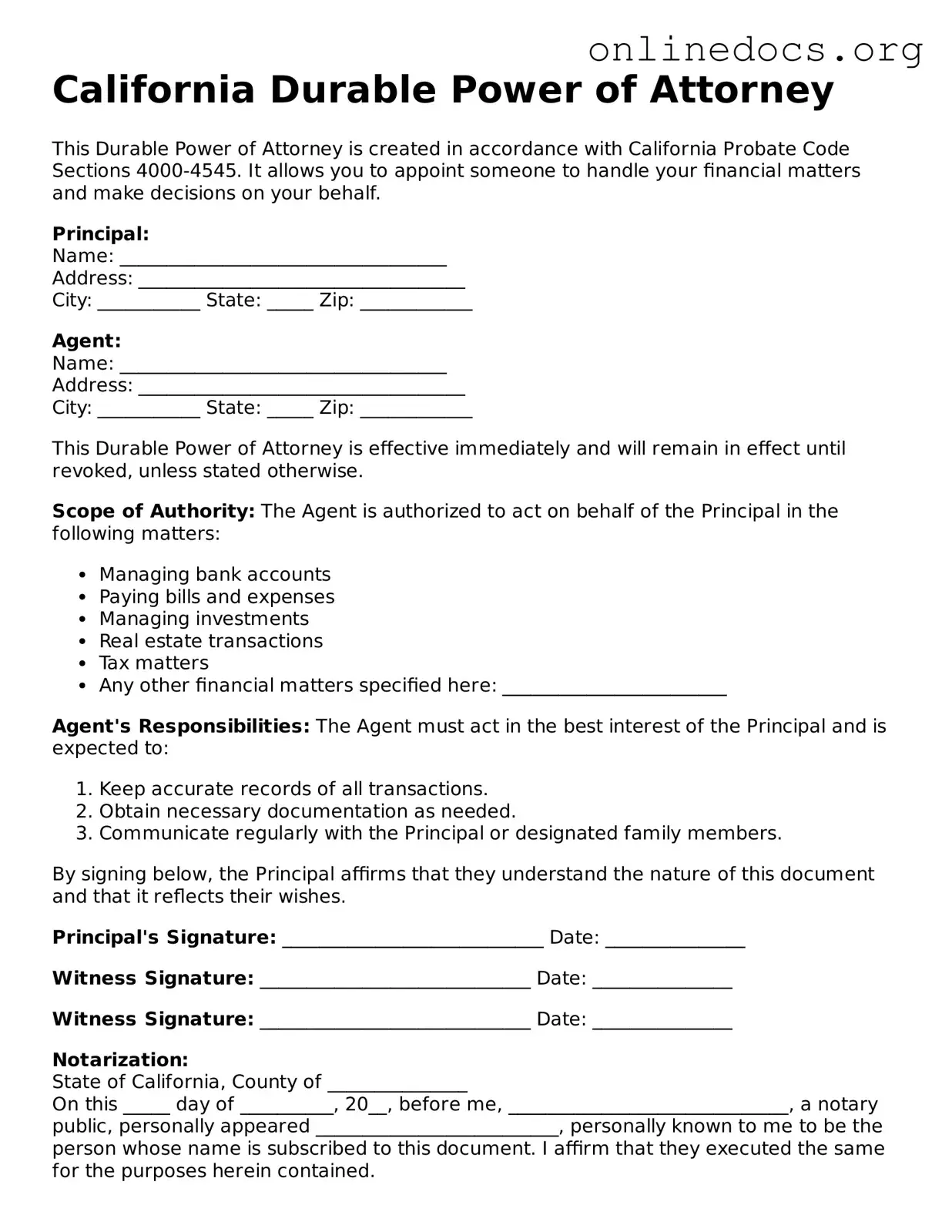The California Durable Power of Attorney (DPOA) form is similar to a General Power of Attorney (GPOA). Both documents allow an individual, known as the principal, to designate someone else, called the agent, to make decisions on their behalf. However, the key difference lies in durability. While a GPOA becomes ineffective if the principal becomes incapacitated, a DPOA remains valid even if the principal is unable to make decisions for themselves. This durability feature makes the DPOA a crucial tool for long-term planning.
Another document similar to the DPOA is the Medical Power of Attorney. This form specifically grants an agent the authority to make healthcare decisions for the principal. Like the DPOA, it allows for the appointment of a trusted individual to act on behalf of the principal. However, the Medical Power of Attorney is focused solely on medical and health-related choices, while the DPOA can cover a broader range of financial and legal matters.
The Healthcare Proxy serves a function akin to the Medical Power of Attorney. It designates someone to make medical decisions when the principal is unable to do so. The key similarity lies in the intent to ensure that healthcare decisions align with the principal's wishes. However, the Healthcare Proxy is often used in specific states and may have different legal implications compared to a Medical Power of Attorney.
A Living Will is another document that complements the Durable Power of Attorney. While the DPOA allows someone to make decisions on behalf of the principal, a Living Will outlines the principal’s wishes regarding medical treatment in scenarios where they cannot express their desires. This document ensures that the agent appointed through the DPOA understands the principal’s preferences concerning life-sustaining treatments.
The Revocable Trust shares similarities with the DPOA in terms of asset management. Both documents allow for the management of the principal's assets, but they operate differently. A Revocable Trust can hold assets and allow for their distribution without going through probate. In contrast, a DPOA grants an agent the authority to manage assets while the principal is still alive, but it does not provide the same level of control over the assets as a trust.
Financial Power of Attorney is closely related to the DPOA but focuses specifically on financial matters. This document empowers an agent to handle the principal's financial affairs, such as paying bills, managing investments, and filing taxes. While the DPOA can encompass both financial and legal decisions, the Financial Power of Attorney is strictly limited to financial responsibilities.
The Guardianship Agreement is another similar document, particularly in the context of protecting an individual who cannot make decisions for themselves. It appoints a guardian to make decisions for a minor or an incapacitated adult. While the DPOA allows for a designated agent to act on behalf of the principal, a Guardianship Agreement involves a court process and is often used when no DPOA is in place.
The Advance Healthcare Directive combines elements of both the Medical Power of Attorney and the Living Will. This document allows individuals to specify their healthcare preferences and appoint an agent to make decisions on their behalf. Like the DPOA, it ensures that the principal’s wishes are respected, especially in critical medical situations.
Understanding the various power of attorney documents is crucial for effective personal and financial planning. For those looking to solidify their lease agreements in New York, resources like legalformspdf.com provide essential forms that ensure clarity in rental arrangements, similar to how durable powers of attorney can safeguard one's affairs.
A Declaration of Guardian is similar to the Guardianship Agreement but is often used for individuals who want to specify who they would prefer to serve as their guardian in the event of incapacity. This document allows individuals to express their wishes clearly, while the DPOA focuses on granting authority to an agent for decision-making.
Lastly, the Special Power of Attorney is another document that resembles the DPOA. This form allows the principal to grant specific powers to an agent for particular tasks, such as selling property or managing a business transaction. Unlike the broader DPOA, which covers a wide range of powers, the Special Power of Attorney is limited in scope and duration.
